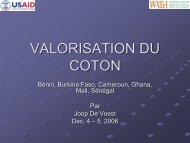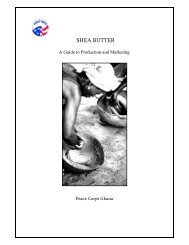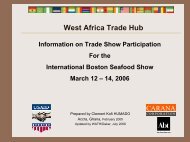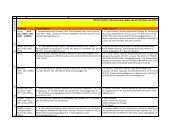A Brief Introduction to Textile Processing - AGOA Export Toolkit
A Brief Introduction to Textile Processing - AGOA Export Toolkit
A Brief Introduction to Textile Processing - AGOA Export Toolkit
Create successful ePaper yourself
Turn your PDF publications into a flip-book with our unique Google optimized e-Paper software.
Figure 8. Batch processing Figure 9. Continuous processing<br />
Printing.<br />
While dyeing a fabric increases its visual appeal <strong>to</strong> consumers, many consumers appreciate<br />
fabrics with multicolor patterns, such as flowers, figures, symbols, or abstract designs. Printing is the<br />
least expensive method for producing such designs. Printing can be done at either the fabric stage, or<br />
with limits, at the garment stage. The most common example of the latter is screen – printed t –<br />
shirts in which a design is printed on<strong>to</strong> a finished t – shirt.<br />
In fabric form, cloth can be printed in continuous process using rollers with the selected pattern, it<br />
can be screen printed, or it can be printed using thermal transfer techniques. Each will be described<br />
below:<br />
Roller<br />
printing. This is a continuous process in which fabric runs over a flat bed or a large cylinder.<br />
While fabric is passing over the bed or cylinder, a series of one <strong>to</strong> several rollers pass over the face, or<br />
“right” side of the fabric. One of two types of rollers will be used: engraved rollers, or screen rollers. In the<br />
former, the metal surface of the roller is engraved with a selected pattern. Dye pigment (concentrate) is<br />
applied <strong>to</strong> the roller, sticking in the engraved areas and transferring the dye <strong>to</strong> the fabric in the same<br />
pattern. In the latter, a fine screen covers the roller. Selected portions of the screen are solid while<br />
others are porous. The porous areas allow dye <strong>to</strong> be forced through in a selected pattern, replicating<br />
that pattern in color on the fabric (called substrate at this stage). Because only one color can be applied<br />
by each roller, most patterns require several rollers. Designers are limited by the number of rollers<br />
that can be used in a given machine. Those machines that pass substrate over a drum or large<br />
cylinder are more limited (usually <strong>to</strong> no more than six rollers, often fewer) than those machines that<br />
pass fabric over a horizontal bed.<br />
Figure 10. Rollers over drum Figure 11. Rollers over flat bed<br />
Great<br />
care must be taken when patterns are designed, <strong>to</strong> make sure the pattern repeat conforms <strong>to</strong><br />
the surface of the rollers used. If the pattern repeat is greater than the circumference of the rollers, a<br />
portion of the pattern will be cut off, causing a rupture in the printed pattern. If the pattern repeat is<br />
shorter than the circumference of the roller, there will be a gap in the pattern once printed. In<br />
addition, rollers must be placed on the printing machine with great precision. Each roller must be<br />
carefully synchronized as it lays down the dye <strong>to</strong> form the final pattern. Because the final pattern is<br />
created by overlaying one color at a time, even a minute error in the placement of any roller will<br />
result in one color in the pattern shifting, causing the fabric <strong>to</strong> be defective and generally unusable.<br />
In a similar fashion, wax prints are created by using rollers <strong>to</strong> apply wax <strong>to</strong> the fabric substrate in a<br />
selected pattern. Fabric is then dyed. The wax resists the dye, or prevents the dye from penetrating the<br />
fabric, leaving those parts of the fabric covered with wax <strong>to</strong> be the color of the substrate. The wax is<br />
Prepared by Margaret Bishop and Brent Smith for the West Africa Trade Hub 8/04 12









